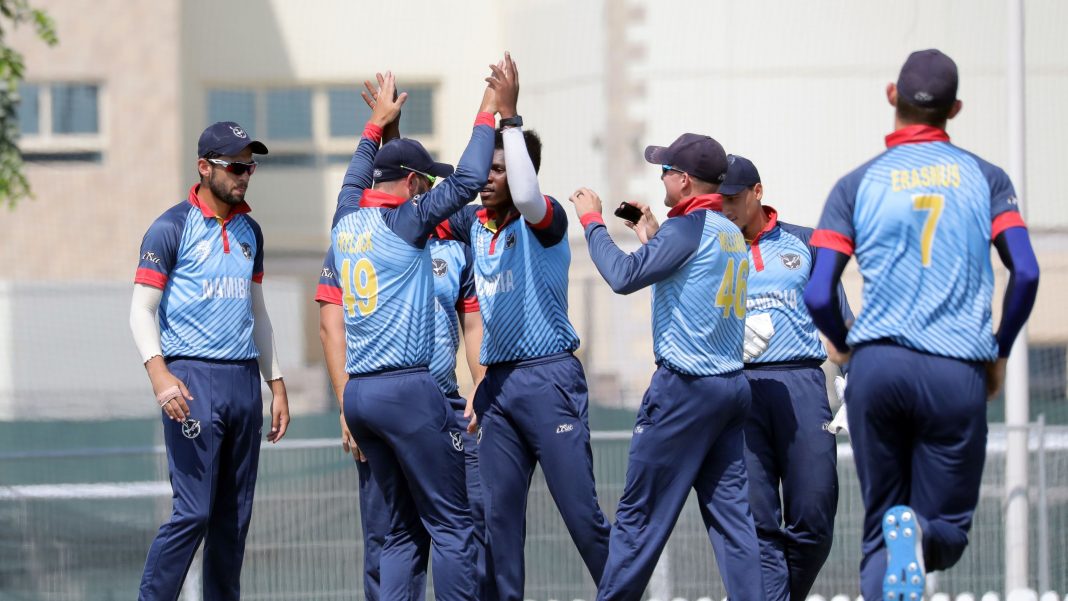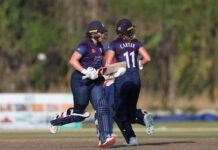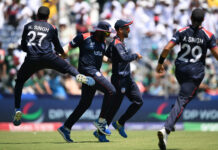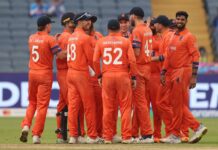From exile when I return
I’m going to beg someone
to introduce the newly-born babies
help me identify those grown-ups
and lead me to the cemetery
where friends and playmates have long gone.
The late national poet of Namibia, Mvula ya Nangolo, wrote those words about a long exile in Europe during his nation’s independence struggle. But they could equally apply to Namibian cricket, with the men’s side spending a generation in the wilderness since their last appearance at an ICC global event, the 2003 World Cup. Qualifying for that event was its own story, but since then, veterans have retired, whole careers come and gone, and newly-born babies in 2003 are now the grown-ups who led Namibia’s return to the top table.
It was 2019, a year after the retirement of Sarel Burger (the last remaining member of the 2003 team) that Namibia’s exile ended. In April, they qualified at home to claim ODI status and a place in the ICC’s Cricket World Cup League 2, then in October of that year they finally made it back to a world cup. It was not for want of trying – Namibia were strong contenders at each of the T20 World Cup Qualifiers they contested between 2012, 2013 and 2015; they went undefeated in the group stage of 2012, and boasted the player of the series (Bernard Scholtz) and leading runscorer (Stephan Baard) in 2015. But each time they crashed out in the playoffs.
So there was no small amount of relief when they secured the fourth of six qualifying places for the 2020 Men’s T20 World Cup in Australia (as it was then planned to be). The drought-breaking win against Oman was as emphatic as any of the African nation’s rainy season downpours, and the 54-run triumph under lights at the Dubai International Cricket Stadium was their fifth consecutive victory in the tournament after they recovered from two early losses. It was also a rematch of their knockout loss in 2015, where the Sultanate cruised home with 5 wickets and an over to spare. Namibia’s rejuvenated side played fearlessly this time, trusting the instincts they had been honing all year, and were rewarded.
Their opening group matches were less settled, with numerous shuffles to both the batting and bowling order as Gerhard Erasmus tinkered with his tactics and team selection. Dutch champion Ryan ten Doeschate made the difference in their tournament opener against the Netherlands, and they were flattened by a trademark Tony Ura assault in their second match against PNG. But after a wobbly start against Scotland, JJ Smit’s lower-order revival (43 off 22) seemed to stabilise both the innings and their campaign, and the Namibians rallied. Coalescing around their inspirational skipper Erasmus (who was named player of the tournament for his 268 runs at 38.28 and a strike-rate of 137.43) in the middle order, and late bursts from Smit (190 runs at 27.14 and a 168.14 strike-rate), the Namibian batting lineup possessed the ability to clear the rope from anywhere in the order as they blasted the most sixes in the tournament. Smit was in the thick of it in the decisive match against Oman, belting 59 (25) to set up a challenging total of 161/7.
He was also a threat with his canny left-arm seam, collecting the most wickets for Namibia (16 at 13.31 and a tidy economy rate of 6.42). Jan Frylinck, another left-armer, extracted useful swing with the new ball to deliver several incisive spells on his way to 15 wickets at 10.4 and 6.24 RPO – his best being the 4/21 as Namibia thumped Singapore by 87 runs in their final group match to claim the crucial third place (and with it, two chances at qualifying).
Veteran left-arm orthodox Bernard Scholtz was the rock of Namibia’s middle over plans, tying down his end with 15 wickets and a miserly economy rate of 5.34 (fifth stingiest of any bowler), while his 35 overs were the most by anyone in the tournament. His spell of 3/14 was decisive in Namibia’s defence against Oman, as he removed the set pair of Aqib Ilyas and Khawar Ali who had taken Oman to 57/1 in the powerplay.
With explosive batting and a core of tidy bowlers and wicket-taking options, Namibia looked threatening in every game, though it was perhaps instructive that they lost four out of five matches batting second (their only successful chase coming against the winless Bermuda, and even that with a slight wobble) – their greatest weakness always seemed to be a frame of mind that left them vulnerable to going too hard even when circumstances required caution.
You’re reading Emerging Cricket — brought to you by a passionate group of volunteers with a vision for cricket to be a truly global sport, and a mission to inspire passion to grow the game.
Be sure to check out our homepage for all the latest news, please subscribe for regular updates, and follow EC on Twitter, Facebook, LinkedIn and YouTube.
Don’t know where to start? Check out our features list, country profiles, and subscribe to our podcast.
Support us from US$2 a month — and get exclusive benefits, by becoming an EC Patron.







